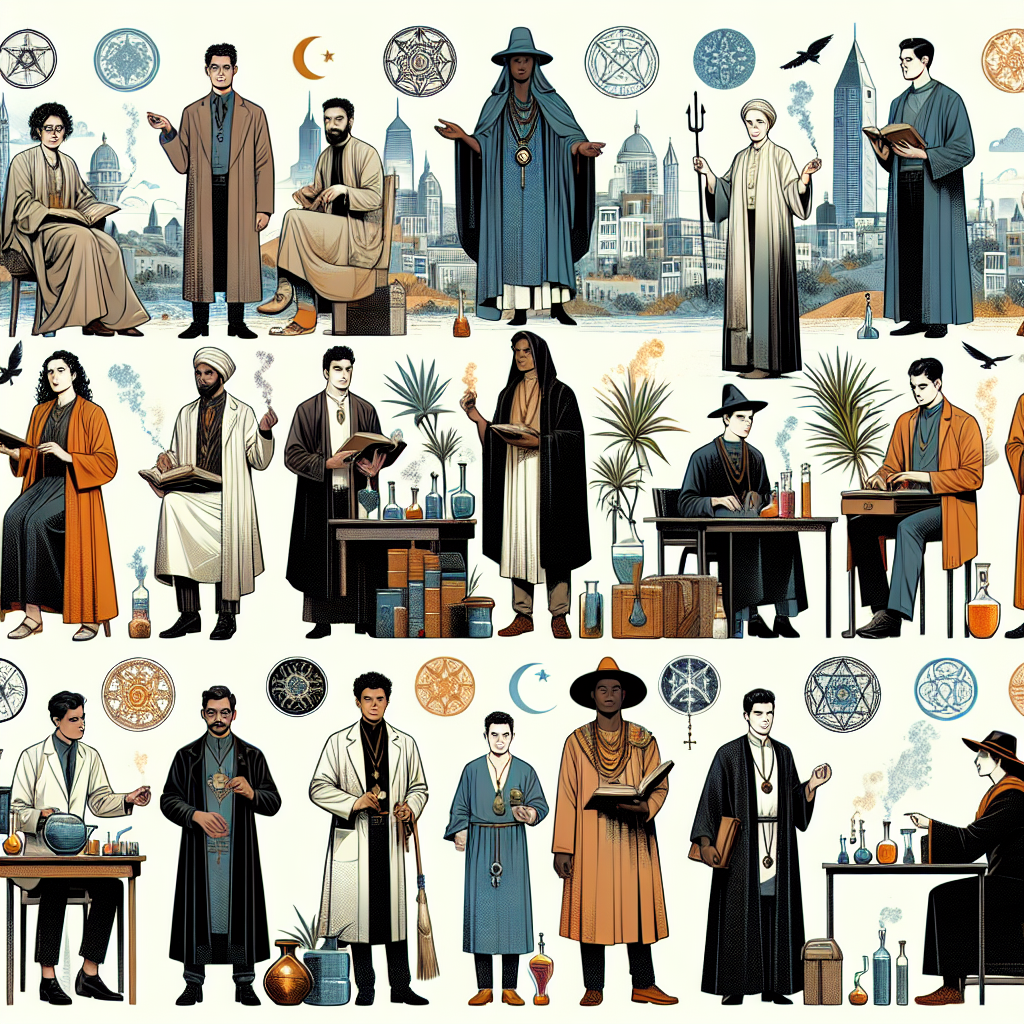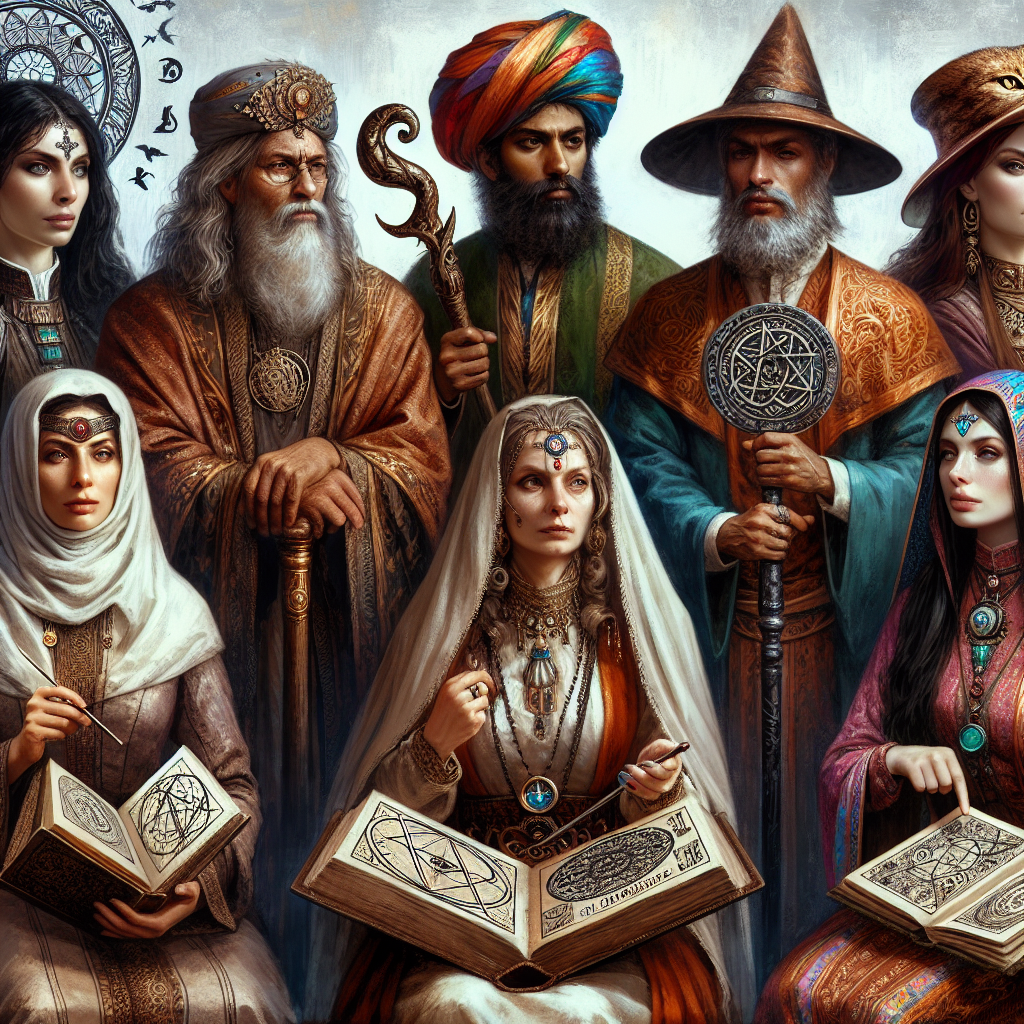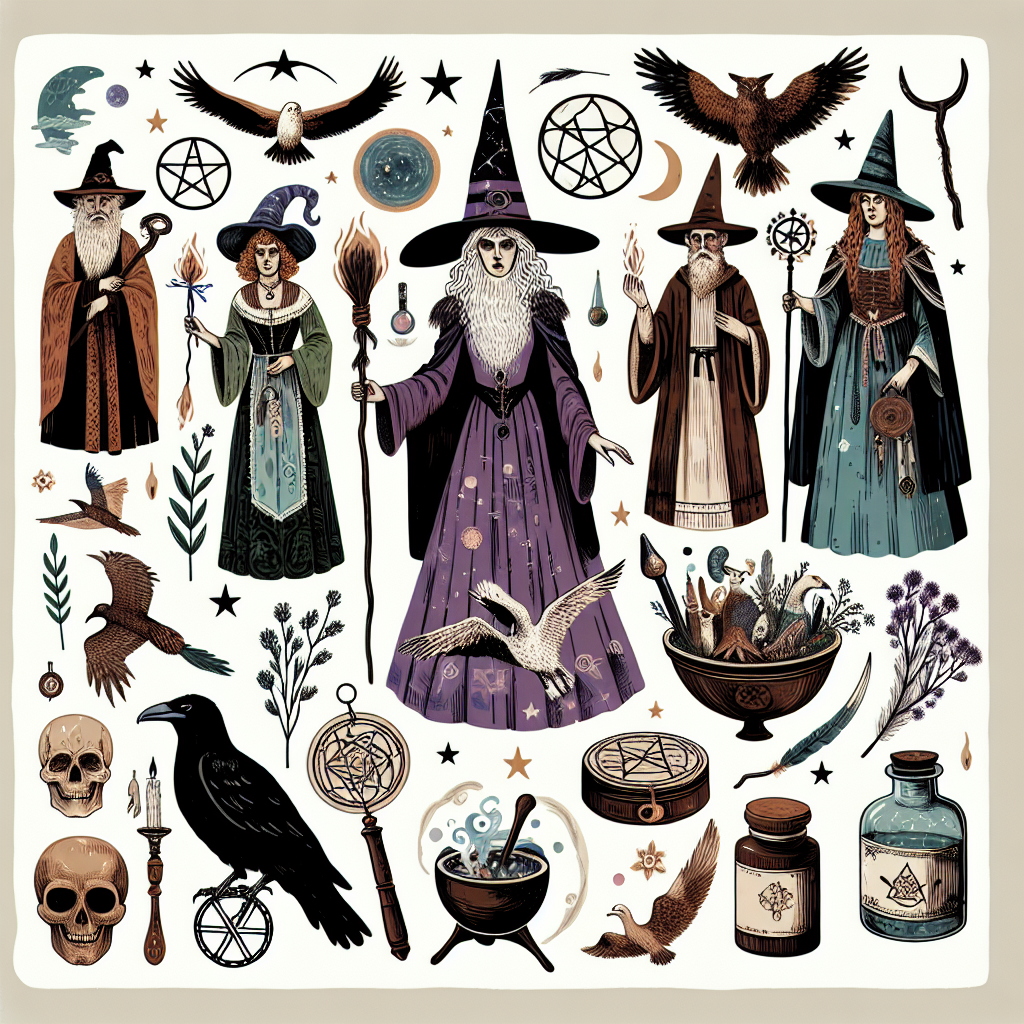As an Amazon Associate I earn from qualifying purchases.

An Ever-Evolving Craft: 16 Key Figures Who Shaped Modern Witchcraft
Understanding Modern Witchcraft
Modern witchcraft, often referred to as Wicca or contemporary Paganism, is an evolving spiritual path that integrates ancient practices with new adaptations. Today, it’s embraced by thousands worldwide, symbolizing a resurgence of interest in nature worship and personal spirituality. The mesmerizing growth can be attributed to several influential figures who brought modern witchcraft to the forefront, each contributing unique perspectives and practices to the tradition.
Gerald Gardner
Gerald Gardner is often considered the “Father of Modern Wicca.” He publicized the craft in the 1950s, claiming to have been initiated into a coven of witches in England. Gardner combined elements from various esoteric traditions, creating a new religious movement that focuses on the worship of the Goddess and God, and the practice of ceremonial magic.
Doreen Valiente
Doreen Valiente, known as the “Mother of Modern Witchcraft,” was a high priestess and a poet who worked closely with Gerald Gardner. She authored many of the foundational texts of Wicca, including ritual scripts and invocations, refining Gardner’s original material and making it more accessible.
Raymond Buckland
Raymond Buckland was a pivotal figure in bringing Gardnerian Wicca to the United States. He established the first Gardnerian coven in America and wrote several influential books on witchcraft, making the practices more widely understood and practiced in the West.
Margot Adler
Margot Adler was a journalist and author who played a crucial role in demystifying and popularizing modern witchcraft. Her book, “Drawing Down the Moon,” is a comprehensive survey of the Pagan movement in America and remains a seminal text.
Scott Cunningham
Scott Cunningham was an author who made solitary witchcraft accessible to a broader audience. His pragmatic and approachable writing style in “Wicca: A Guide for the Solitary Practitioner” and other books helped countless people practice witchcraft independently.
Aleister Crowley
Aleister Crowley was a controversial occultist whose work significantly influenced modern witchcraft. Known for his philosophy of Thelema, Crowley’s writings and rituals were integrated into some forms of witchcraft, blending elements of ceremonial magic with Pagan practices.
Sybil Leek
Sybil Leek was a prominent English witch and astrologer known for her charismatic media presence. She moved to the United States in the 1960s and helped to destigmatize witchcraft through her books and television appearances.
Laurie Cabot
Laurie Cabot, known as the “Official Witch of Salem,” has been a key figure in making witchcraft a respected spiritual path. She founded The Cabot Tradition of the Science of Witchcraft, combining Wiccan spirituality with the scientific study of energy and consciousness.
Z. Budapest
Zsuzsanna Budapest, or Z. Budapest, is a feminist witch who founded the Dianic Wiccan tradition. She emphasized women’s spirituality and goddess worship, creating a female-centric branch of modern witchcraft.
Stewart and Janet Farrar
Stewart and Janet Farrar were influential figures in both written and practical aspects of witchcraft. Their book, “A Witches’ Bible,” is considered one of the most comprehensive guides to Wicca, and their work has informed the practices of many modern covens.
Starhawk
Starhawk is a renowned author and activist who has deeply influenced modern witchcraft with her eco-feminist perspectives. Her book, “The Spiral Dance,” is a key text in linking spiritual practice with environmental activism, emphasizing the sacredness of nature.
Victor and Cora Anderson
Victor and Cora Anderson were the founders of the Feri Tradition, which has enriched the tapestry of modern witchcraft. Their teachings focus on ecstatic practices and personal spiritual experience, diverging from more structured Wiccan traditions.
Oberon Zell-Ravenheart
Oberon Zell-Ravenheart is co-founder of the Church of All Worlds, a prominent Pagan church that draws on fiction and mythology to create its religious framework. His efforts have contributed to the recognition and organization of Paganism as a legitimate religion.
Phyllis Curott
Phyllis Curott is a high-profile lawyer and Wiccan priestess who has worked to legalize and legitimize witchcraft as a mainstream religion. Her books provide practical guidance and legal advice for practicing witchcraft within the modern societal framework.
Selena Fox
Selena Fox is the founder of Circle Sanctuary, a prominent sanctuary for Pagan worship. She has played a significant role in legal and social advocacy for Pagan practices, including efforts to have Pagan symbols recognized on military headstones.
Alex Sanders
Alex Sanders, often referred to as the “King of the Witches,” founded the Alexandrian tradition of Wicca. His charismatic personality and innovative blend of ceremonial magic with Wiccan practices have inspired numerous followers.
#### 16 Key Figures Who Shaped Modern Witchcraft
**Gerald Gardner**: Often dubbed the “Father of Wicca,” Gerald Gardner was instrumental in bringing the practices of contemporary witchcraft to the forefront. A retired civil servant, Gardner claimed to have been initiated into a coven in the New Forest. His books, “Witchcraft Today” (1954) and “The Meaning of Witchcraft” (1959), laid the groundwork for what would become modern Wicca. Gardner’s combination of ancient rites, ceremonial magic, and nature worship defined the core tenets of the religion.
**Doreen Valiente**: Known as the “Mother of Modern Witchcraft,” Doreen Valiente was a key figure in the shaping of Gardnerian Wicca. A poet and high priestess, Valiente collaborated with Gardner to rewrite much of the ritual material, making it more accessible and practical. Her contributions include the “Charge of the Goddess,” a central text in Wiccan practice.
**Alex Sanders**: Dubbed the “King of the Witches,” Alex Sanders founded the Alexandrian tradition of Wicca, which is very similar to Gardnerian Wicca but emphasizes ceremonial magic and incorporates elements of Qabala. Sanders’ charismatic personality and media appearances helped to popularize modern witchcraft.
**Raymond Buckland**: A close associate of Gardner, Raymond Buckland brought Gardnerian Wicca to the United States. Known for establishing the first Wiccan coven in America, Buckland wrote several influential books, including “The Tree: The Complete Book of Saxon Witchcraft,” creating the Seax-Wica tradition, an accessible form of Wicca that invites solitary practice.
**Margaret Murray**: Although not a practicing witch, Margaret Murray was a pioneering academic whose work laid the historical foundation for modern pagan practices. Her books, such as “The Witch-Cult in Western Europe” (1921), proposed the existence of a secret, pre-Christian pagan religion, a theory that fueled the interest in historical witches and magical pioneers.
**Sybil Leek**: One of the most famous British witches of the 20th century, Sybil Leek broke many stereotypes associated with witchcraft. A prolific author and media personality, her autobiography “Diary of a Witch” (1968) demystified the life of a modern witch. Leek combined traditional witchcraft with aspects of astrology, further enriching contemporary practices.
**Robert Cochrane**: Known for his enigmatic and poetic approach to witchcraft, Robert Cochrane founded the Clan of Tubal Cain, a tradition emphasizing the mystical and shamanic aspects of the craft. His writings and letters to other witches reveal a path deeply rooted in folklore and the mysteries of the British countryside.
**Starhawk**: A central figure in the reclaiming tradition, Starhawk’s work in eco-feminism and activism has been influential in modern witchcraft. Her seminal book, “The Spiral Dance” (1979), blends spiritual practice with political engagement, making witchcraft a tool for social change.
**Selena Fox**: A pioneering figure in American witchcraft, Selena Fox founded the Circle Sanctuary, a notable Wiccan church and nature preserve. As an advocate for religious freedom, Fox has played a crucial role in gaining legal recognition for Wiccan practices and symbols.
**Laurie Cabot**: Often referred to as the “Official Witch of Salem,” Laurie Cabot has been a tireless advocate for witchcraft as a legitimate spiritual path. Her store, The Cat, The Crow, and The Crown, and her books have been instrumental in educating the public about witchcraft.
**Janet and Stewart Farrar**: This couple’s extensive writings and teachings have been key to the spread of Alexandrian Wicca. Their book “A Witches’ Bible” (1984) is one of the most comprehensive guides to modern witchcraft rituals and philosophy.
**Z. Budapest**: A feminist witch, Z. Budapest has been a strong proponent of Dianic Wicca, a tradition that emphasizes the divine feminine. Her book “The Holy Book of Women’s Mysteries” helped many women reconnect with feminine spirituality.
**Oberon Zell-Ravenheart**: Co-founder of the Church of All Worlds, Oberon Zell-Ravenheart has been a major influence in the neo-pagan movement. His work in promoting polytheism and creating pagan communities has enriched the landscape of modern witchcraft. He is also known for his role in reviving interest in ancient mythologies through his writings and publications like “The Green Egg.”
**Scott Cunningham**: With a focus on solitary practice, Scott Cunningham’s books such as “Wicca: A Guide for the Solitary Practitioner” have made witchcraft accessible to those without a coven. His approachable style and comprehensive guides demystify the craft for beginners.
**Patricia Crowther**: A direct initiate of Gerald Gardner, Patricia Crowther has written several books and maintained a long-standing dedication to the tradition. Her autobiography “Witch Blood!” touches on her role in the shaping of modern witchcraft and her deep connections to its roots.
**Caitlin Matthews**: As a scholar and practitioner, Caitlin Matthews has significantly influenced modern Druidry and Celtic spirituality. Her works often blend folklore, mythology, and practical rituals, making them highly valuable for both new and seasoned practitioners interested in ancient traditions.
According to recent statistics, interest in modern witchcraft has surged, with more young adults identifying as neo-pagans or witches, demonstrating the lasting influence of these key figures.
Gerald Gardner
During my early years exploring modern witchcraft, I stumbled across Gerald Gardner’s writings and was immediately captivated. Gardner’s work introduced me to Wicca, which he is often credited with founding. His detailed rituals and emphasis on ceremonial magic provided structure that I found incredibly grounding as a novice.
Reading “Witchcraft Today” was a transformative experience. It not only enriched my knowledge but also made me feel part of a larger community seeking similar spiritual truths. Gardner’s approach to incorporating ancient traditions with contemporary practices resonated deeply with me, leading me to adopt many of his methods in my own rituals.
Attending a Gardnerian coven meeting felt like coming full circle. The rituals, steeped in Gardner’s teachings, filled me with a sense of historical continuity and deepened my practice. Meeting others who were equally inspired by his work solidified my connection to modern witchcraft.
Doreen Valiente
Doreen Valiente’s poetry and rituals were a breath of fresh air. When I first read her work, I was struck by the beauty and depth of her writings. Her influence on modern witchcraft, especially in refining Gardner’s early teachings, was evident and invaluable.
Participating in rituals that included her well-crafted incantations allowed me to feel the power of words in a new light. Valiente’s ability to weave poetic elegance with spiritual potency is something I strive to emulate in my own practice. Her work made me appreciate the artistry involved in crafting meaningful rituals.
The opportunity to attend a workshop dedicated to Valiente’s methods provided further insight into her influence. Learning from practitioners who had studied under her emphasized her lasting impact on modern witchcraft. It was a magical experience that deepened my respect for her contributions.
Raymond Buckland
Raymond Buckland’s books were my first real foray into the practical aspects of witchcraft. His straightforward, accessible writing style helped demystify many of the complex rituals and techniques I had encountered in other texts.
Studying Buckland’s complete book of witchcraft equipped me with a solid foundation in various magical practices, from spell-casting to sabbat celebrations. His emphasis on personalization and creativity encouraged me to find my own path within the broader framework of modern witchcraft.
Being part of a local pagan group that followed Buckland’s teachings was incredibly rewarding. His practical advice and no-nonsense approach made it easier for us to integrate witchcraft into our daily lives. His influence on modern witchcraft is undeniable, and I continue to refer back to his works frequently.
Margot Adler
In the search for more intellectually stimulating material, Margot Adler’s “Drawing Down the Moon” was a revelation. Her comprehensive study of pagan practices in America provided a much-needed academic perspective that enriched my understanding of modern witchcraft.
Adler’s interviews with various practitioners gave me a sense of the diversity within the witchcraft community. It was eye-opening to see how different people adapted ancient traditions to fit into modern life. This broadened my views and made me appreciate the flexibility and inclusivity of modern witchcraft.
Engaging in online forums and discussions inspired by Adler’s work was a great way to exchange ideas with other practitioners. Her scholarly approach validated my own intellectual curiosity and made me realize that witchcraft can be both a spiritual and academic pursuit.
u003ch2u003e1. Who are some of the most influential figures in modern witchcraft?u003c/h2u003e
u003cpu003eModern witchcraft has been shaped by various figures including Gerald Gardner, Doreen Valiente, and Scott Cunningham. Each of these individuals brought unique contributions to the practice and understanding of witchcraft today.u003c/pu003e
u003ch2u003e2. What role did Gerald Gardner play in the development of Wicca?u003c/h2u003e
u003cpu003eGerald Gardner is often credited with founding Wicca in the mid-20th century. He published several books that laid the groundwork for the modern Wiccan movement and helped bring witchcraft to public attention.u003c/pu003e
u003ch2u003e3. Why is Doreen Valiente considered a significant figure in witchcraft?u003c/h2u003e
u003cpu003eDoreen Valiente is known as the “Mother of Modern Witchcraft” due to her extensive work in writing rituals and poetry that form the basis of many Wiccan practices. She collaborated closely with Gerald Gardner and made significant contributions to Wicca and Neo-Paganism.u003c/pu003e
u003ch2u003e4. What contributions did Scott Cunningham make to modern witchcraft?u003c/h2u003e
u003cpu003eScott Cunningham wrote extensively on the practice of solitary witchcraft, making it accessible to individuals without coven membership. His books, such as “Wicca: A Guide for the Solitary Practitioner,” are still widely read and respected.u003c/pu003e
u003ch2u003e5. Can you name a historical figure known for being accused of witchcraft?u003c/h2u003e
u003cpu003eOne well-known historical figure accused of witchcraft is Joan of Arc. She was accused of heresy and witchcraft by the English and was ultimately burned at the stake in 1431. However, she was later canonized as a saint by the Catholic Church.u003c/pu003e
u003ch2u003e6. Who are some magical pioneers in the context of modern witchcraft?u003c/h2u003e
u003cpu003eMagical pioneers in modern witchcraft include Aleister Crowley, who founded Thelema, and Alex Sanders, who established Alexandrian Wicca. They both contributed significantly to the development of contemporary magical practices.u003c/pu003e
u003ch2u003e7. Why is Aleister Crowley important to modern occultism?u003c/h2u003e
u003cpu003eAleister Crowley is significant for his development of Thelema, a spiritual philosophy that has influenced various modern occult and esoteric movements. His writings and practices emphasize personal freedom and self-discovery.u003c/pu003e
u003ch2u003e8. What influence did Alex Sanders have on witchcraft?u003c/h2u003e
u003cpu003eAlex Sanders, known as the “King of the Witches,” founded Alexandrian Wicca, which incorporates eclectic rituals and practices. His approach helped to diversify and broaden the scope of modern witchcraft.u003c/pu003e
u003ch2u003e9. Who are some current influencers in the world of witchcraft?u003c/h2u003e
u003cpu003eCurrent influencers in the world of witchcraft include authors like Silver RavenWolf, practitioners like Laurie Cabot, and social media personalities who promote various aspects of witchcraft and Paganism online.u003c/pu003e
u003ch2u003e10. What role do spiritual leaders play in modern witchcraft?u003c/h2u003e
u003cpu003eSpiritual leaders in modern witchcraft often serve as guides, educators, and community organizers. They help to preserve and disseminate traditional practices while also adapting to contemporary spiritual needs.u003c/pu003e

## Conclusion
The 16 key figures who shaped modern witchcraft encompass a diverse range of historical witches, magical pioneers, spiritual leaders, and influential contemporary voices who have each left an indelible mark on the practice and perception of witchcraft today. Their contributions span the realms of literature, spiritual praxis, and advocacy, underpinning a rich tapestry of esoteric knowledge and cultural transformation. From the foundations laid by Gerald Gardner, regarded as the father of modern Wicca, to the influential works of Doreen Valiente, the craft’s most beloved poet, these individuals have helped to reclaim and redefine witchcraft in the modern era. Moreover, figures such as Aleister Crowley and Helena Blavatsky have broadened the horizons of magical practice and the occult, while modern practitioners like Starhawk and Laurie Cabot have inspired countless followers through their public engagement and accessible teachings.
Collectively, these key figures highlight the evolution of witchcraft from its persecuted past to a thriving, diverse spiritual movement. The historical witches who faced persecution serve as poignant reminders of the past struggles and resilience, inspiring modern practitioners to honor their legacy while pushing for broader acceptance and understanding. Meanwhile, contemporary influencers like Scott Cunningham and Silver RavenWolf have demystified practices, making witchcraft approachable for newcomers. This dynamic interplay of historical and modern elements ensures that witchcraft remains a vibrant, ever-evolving spiritual path, firmly rooted in its rich history but continuously growing and adapting to the needs of present and future generations.
Amazon and the Amazon logo are trademarks of Amazon.com, Inc, or its affiliates.


